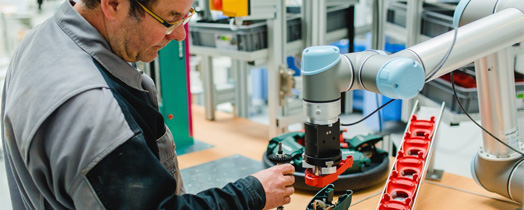Lightweight robots in manual assembly

What is the current state of cage-free robot technology in German industry? This was the question Fraunhofer IAO investigated in the study “Lightweight robots in manual assembly.” Based on case studies in factories already using lightweight robots for manufacturing, the study looked at their experiences with implementing the robots, gaining acceptance from human coworkers, and improving operational efficiency.
In recent years, human-robot cooperation – also known as human-robot collaboration, or HRC – has taken center stage at trade fairs. The term applies to any situation where robots work directly alongside humans without safety barriers on the manufacturing floor.
In such cases, the work zones of robots and workers overlap instead of being strictly separated. The low entry prices and big media interest in the technology created a wave of hype. But is the cost really all that low, and are the new robots really safe? Or is it a case of companies having unrealistic expectations?
Meet your new robotic workmate: initial hurdles and sample applications
In the course of the study “Lightweight robots in manual assembly – best to start simply,” Fraunhofer IAO researched cage-free robot use in Germany in industrial companies and in publications. From some 50 applications, 25 were ultimately selected for further investigation – of these, 18 were taken from personal interviews and 7 from publications. The decisive criterion for selection was that the application was already operating on a production line or that the robots were already being used by several companies.
First and foremost, the study reveals that the new technology works! This was confirmed by all the one-to-one interviews conducted. Even if the technology itself is not being called into question, however, there are still some uncertainties – for example, as regards new occupational safety standards and guidelines.
In addition, the cost of cage-free operation is significantly higher than initially expected. The study also showed that humans and robots are still primarily working alongside each other in a form of coexistence, with genuine collaborative applications virtually non-existent in production facilities at the present time. To ensure that the purchase costs of a lightweight robot pay off, it is also important to keep the new robotic worker busy.
Who dares wins: take the plunge!
How can companies benefit in the future from current knowledge and experience? After the project, the interviewees all agreed that the bottom line is: “Don’t let obstacles put you off – best to start simply!” Fraunhofer IAO’s Manfred Bender, who headed the study, explains: “What’s particularly important here is to choose an application that will work. In other words, the application must not be too complex and must have simple requirements in regard to materials provisioning. For safe assembly processes, pointed or sharp parts should also be excluded.”
The study is available both as a printed document and as a PDF for download at http://s.fhg.de/Studie-LBR. The follow-up project “Rococo: designing human-robot assembly-line collaborations that are cooperative and integrated” starts on October 1, 2016. It is being funded by the German Federal Ministry of Education and Research (BMBF) and coordinated by the Project Management Agency Karlsruhe (PTKA).
Contact:
Manfred Bender
E-Mail: manfred.bender@iao.fraunhofer.de
Phone: +49 711 970-2056
https://www.iao.fraunhofer.de/lang-en/about-us/press-and-media/1276-lightweight-…
http://s.fhg.de/Studie-LBR
https://www.iao.fraunhofer.de/lang-de/veranstaltungen/eventdetail/381.html
Media Contact
All latest news from the category: Machine Engineering
Machine engineering is one of Germany’s key industries. The importance of this segment has led to the creation of new university degree programs in fields such as production and logistics, process engineering, vehicle/automotive engineering, production engineering and aerospace engineering among others.
innovations-report offers informative reports and articles covering technologies such as automation, motion, power train, energy, conveyor, plastics, lightweight construction, logistics/warehousing, measurement systems, machine tools and control engineering.
Newest articles

NASA: Mystery of life’s handedness deepens
The mystery of why life uses molecules with specific orientations has deepened with a NASA-funded discovery that RNA — a key molecule thought to have potentially held the instructions for…

What are the effects of historic lithium mining on water quality?
Study reveals low levels of common contaminants but high levels of other elements in waters associated with an abandoned lithium mine. Lithium ore and mining waste from a historic lithium…

Quantum-inspired design boosts efficiency of heat-to-electricity conversion
Rice engineers take unconventional route to improving thermophotovoltaic systems. Researchers at Rice University have found a new way to improve a key element of thermophotovoltaic (TPV) systems, which convert heat…



